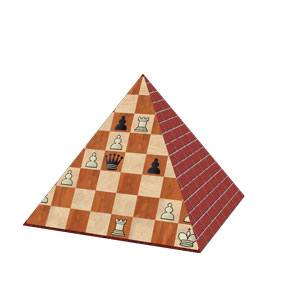Total Chess: Finding Tactics

Tactics are moves that help you win pieces. When you win pieces, you gain points and take the lead in material. When you take the lead in material, you have a better chance to win the game. Tactics also make immediate threats to gain advantage. Sometimes, just the threat to use tactics can improve your position, or weaken the opponent’s position.
Tactics are the heart of chess. They are always there, all of the time. Whether or not you can find tactics is another matter. You must know what to look for before you can find tactics.
When you are looking for tactics, you need to look for forcing moves. Forcing moves are moves to which the opponent must respond. His choices are limited because he must react to your moves. He is not free to make any move he wants. When you use forcing moves, you can predict what the opponent’s next move will be, because he only has a few choices. You can use forcing moves to help you setup tactics.
1) Captures: When you capture a piece, the opponent must capture back or else fall behind in material. Therefore, you can use captures to force the opponent’s next move. He probably has to recapture, so you can predict what his next move will be.
2) Checks: When you put the opponent’s king in check, he must get out of check. There will always be a limited number of ways for the opponent to get out of check, so you can predict what his next move will be. Checks are the most powerful forcing moves.
3) Threats: When you make a threat, the opponent must defend against the threat. You can threaten to capture a piece, threaten to use a tactic, or threaten checkmate. This forces the opponent to respond to your move, so you can predict what his next move will be. When the opponent makes a threat, there is also another way for you to respond. Make a bigger threat. When you make a bigger threat, you force the opponent to respond to your threat.
Now that you know what forcing moves are, you can learn about combinations. A combination is a sequence of forcing moves ending with a tactic. It would be nice if all tactics happened in just one move, but chess is not that simple. It usually takes more than one move to do a tactic. This is called a combination.
A combination requires you to think ahead more than one move. You have to say to yourself, “If I do this, and the opponent does that, then what can I do next?” You have to think ahead three or more moves. Then you will be able to find combinations. A combination begins with a sequence of forcing moves to get the pieces into the right position for a tactic. They prepare or setup the tactic. When the pieces are ready, then you can do the tactic.
Tactics are organized into eight related groups, with three tactics in each group. The eight groups of tactics are: direct, dynamic, discovered, double, decoy, deflection, defensive and delay. There are 24 lessons for beginner, intermediate and advanced players that explain each of these tactics.
***
From the book, “TOTAL CHESS: Learn, Teach and Play the Easy 1-2-3 Way,” by John Herron
TOTAL CHESS is your complete guide to chess. It covers everything: rules, strategies, tactics and checkmates.
Everything in chess comes in threes. Three simple strategies are presented for the opening, midgame, endgame, etc. Each lesson is brief and covers one concept in simple language that everyone can read and understand.











Comments: